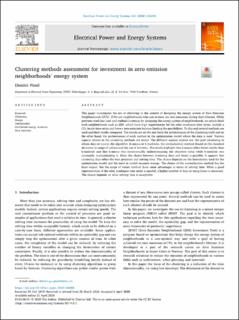| dc.contributor.author | Pinel, Dimitri | |
| dc.date.accessioned | 2021-02-25T09:34:23Z | |
| dc.date.available | 2021-02-25T09:34:23Z | |
| dc.date.created | 2020-04-22T15:52:20Z | |
| dc.date.issued | 2020 | |
| dc.identifier.issn | 0142-0615 | |
| dc.identifier.uri | https://hdl.handle.net/11250/2730287 | |
| dc.description.abstract | This paper investigates the use of clustering in the context of designing the energy system of Zero Emission Neighborhoods (ZEN). ZENs are neighborhoods who aim to have net zero emissions during their lifetime. While previous work has used and studied clustering for designing the energy system of neighborhoods, no article dealt with neighborhoods such as ZEN, which have high requirements for the solar irradiance time series, include a CO2 factor time series and have a zero emission balance limiting the possibilities. To this end several methods are used and their results compared. The results are on the one hand the performances of the clustering itself and on the other hand, the performances of each method in the optimization model where the data is used. Various aspects related to the clustering methods are tested. The different aspects studied are: the goal (clustering to obtain days or hours), the algorithm (k-means or k-medoids), the normalization method (based on the standard deviation or range of values) and the use of heuristic. The results highlight that k-means offers better results than k-medoids and that k-means was systematically underestimating the objective value while k-medoids was constantly overestimating it. When the choice between clustering days and hours is possible, it appears that clustering days offers the best precision and solving time. The choice depends on the formulation used for the optimization model and the need to model seasonal storage. The choice of the normalization method has the least impact, but the range of values method show some advantages in terms of solving time. When a good representation of the solar irradiance time series is needed, a higher number of days or using hours is necessary. The choice depends on what solving time is acceptable. | en_US |
| dc.language.iso | eng | en_US |
| dc.publisher | Elsevier | en_US |
| dc.relation.uri | https://www.sciencedirect.com/science/article/pii/S014206151932561X | |
| dc.rights | Navngivelse 4.0 Internasjonal | * |
| dc.rights.uri | http://creativecommons.org/licenses/by/4.0/deed.no | * |
| dc.title | Clustering methods assessment for investment in zero emission neighborhoods’ energy system | en_US |
| dc.type | Peer reviewed | en_US |
| dc.type | Journal article | en_US |
| dc.description.version | publishedVersion | en_US |
| dc.source.volume | 121 | en_US |
| dc.source.journal | International Journal of Electrical Power & Energy Systems | en_US |
| dc.identifier.doi | 10.1016/j.ijepes.2020.106088 | |
| dc.identifier.cristin | 1807548 | |
| dc.relation.project | Norges forskningsråd: 257660 | en_US |
| dc.description.localcode | © 2020 The Author. Published by Elsevier Ltd. This is an open access article under the CC BY license (http://creativecommons.org/licenses/BY/4.0/). | en_US |
| cristin.ispublished | true | |
| cristin.fulltext | postprint | |
| cristin.fulltext | original | |
| cristin.qualitycode | 1 | |

